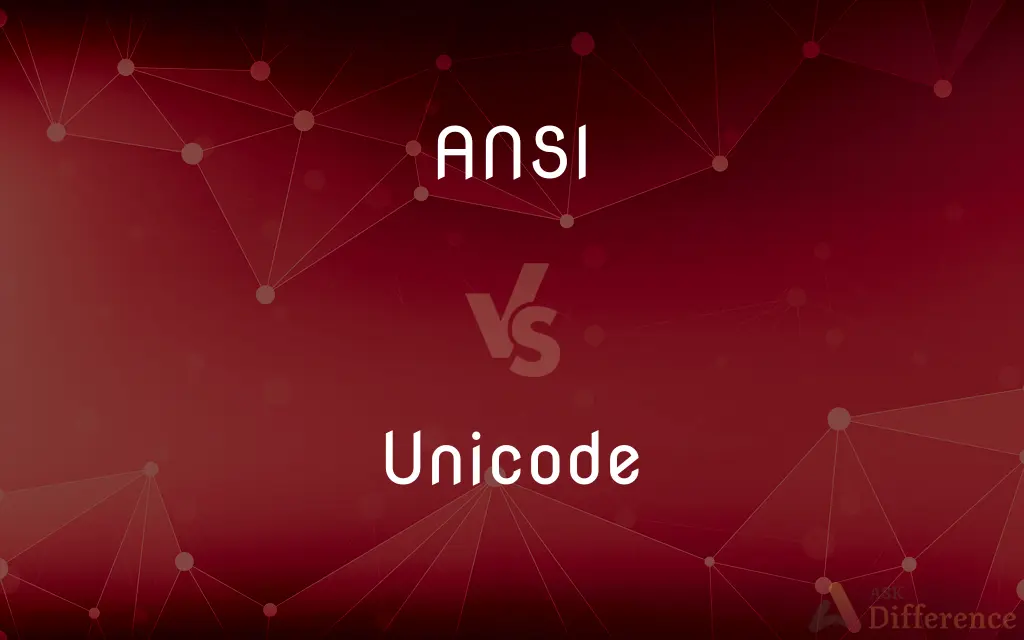ANSI vs. Unicode — What's the Difference?
By Tayyaba Rehman — Published on December 22, 2023
ANSI is a character encoding standard for the English language and a few others, while Unicode is a universal character encoding standard that represents most of the world's written languages.

Difference Between ANSI and Unicode
Table of Contents
ADVERTISEMENT
Key Differences
ANSI is a set of standards by the American National Standards Institute, and when referring to text files, it generally means a character encoding based on a localized version of ASCII. Unicode, on the other hand, is a comprehensive encoding standard that covers characters and symbols from almost every language in the world.
ANSI encoding was predominantly used in earlier Windows systems and is limited in its capacity to represent characters outside of Western languages. Unicode was developed to overcome the limitations of traditional character encoding schemes and can represent a wide variety of characters from different scripts.
In terms of technological evolution, ANSI was sufficient when computing was primarily in English and Western European languages. As the digital world expanded, the need for a more inclusive encoding system arose, leading to the development of Unicode which aims to provide a unique number for every character across languages.
When files are saved in ANSI, there's a risk of character misrepresentation if the file is opened on a system with a different locale. With Unicode, this risk is mitigated as it provides a consistent representation of characters globally.
It's important to note that while ANSI is limited to a few hundred characters, Unicode supports over a million code points, allowing for extensive linguistic and symbol representation, making it the preferred choice in today's multilingual computing environment.
ADVERTISEMENT
Comparison Chart
Definition
Set of standards by American National Standards Institute
Universal character encoding standard
Language Coverage
Primarily English and some Western languages
Almost every language in the world
Character Limit
Limited to a few hundred characters
Supports over a million code points
Risk of Misrepresentation
Possible when opened in different locales
Provides consistent character representation globally
Usage
Predominant in older systems
Preferred in modern, multilingual computing environments
Compare with Definitions
ANSI
ANSI stands for the American National Standards Institute, responsible for developing standards across various sectors.
The document followed the ANSI standard for character encoding.
Unicode
Unicode is integral to modern computing, especially for multilingual environments.
Their software relied on Unicode to cater to diverse user languages.
ANSI
ANSI represents a subset of possible characters, limited to a particular region.
Because the software used ANSI, it couldn't display certain special characters.
Unicode
Unicode is a universal character encoding standard supporting most of the world's written languages.
Using Unicode ensured the website displayed text correctly for international users.
ANSI
ANSI codes are specific to certain locales and might not display correctly outside of them.
She avoided using ANSI encoding for her global project.
Unicode
Unicode provides a unique number for every character, no matter the platform or language.
With Unicode, she was confident her message would appear the same everywhere.
ANSI
ANSI is often used to refer to a specific character encoding based on ASCII.
When the text was saved in ANSI, some characters weren't displayed correctly.
Unicode
Unicode overcomes the limitations of previous encoding schemes and offers a consistent representation globally.
To avoid character misrepresentation, he saved the file in Unicode.
ANSI
ANSI standards are not just about character encoding; they cover a wide range of technical standards.
The company adhered to several ANSI safety standards.
Unicode
Unicode aims to encode all human languages' characters, historic scripts, and symbols.
Scholars appreciated Unicode's ability to represent ancient scripts.
Unicode
A character encoding standard for computer storage and transmission of the letters, characters, and symbols of most languages and writing systems.
Common Curiosities
What is the primary aim of Unicode?
Unicode aims to provide a unique number for every character across languages.
Why was Unicode introduced?
Unicode was introduced to represent characters from almost every global language, overcoming the limitations of older encoding schemes like ANSI.
Can ANSI represent characters from Asian languages?
Generally, ANSI is not suitable for Asian languages due to its limited character set, while Unicode can represent them.
How does ANSI differ from ASCII?
ANSI is based on ASCII but includes additional characters specific to certain locales.
How many characters does Unicode support?
Unicode supports over a million code points, allowing vast linguistic and symbol representation.
What does ANSI stand for?
ANSI stands for the American National Standards Institute.
Which is more modern, ANSI or Unicode?
Unicode is more modern and comprehensive compared to ANSI.
Is ANSI still in use today?
While less common in global applications, ANSI is still used in some legacy systems or specific regional contexts.
Is Unicode used in web development?
Yes, Unicode, particularly UTF-8, is widely used in web development to support global audiences.
Does Unicode only cover alphabets?
No, Unicode covers characters, symbols, and scripts from both current and historical languages.
Why might someone choose ANSI over Unicode?
They might be working with older systems or applications where ANSI is the default or only supported encoding.
Do both ANSI and Unicode have the same representation for English alphabets?
Yes, for basic English characters, the representation in both ANSI and Unicode (specifically UTF-8) is the same.
Is it safe to say Unicode is a superset of ANSI?
In the context of character encoding, yes, Unicode can represent everything ANSI can and much more.
Is ANSI restricted to character encoding?
No, while ANSI can refer to character encoding, the American National Standards Institute covers a wide range of standards beyond just encoding.
Can I convert an ANSI encoded file to Unicode?
Yes, there are tools and software that can convert ANSI encoded files to Unicode, though special characters specific to ANSI might not always translate perfectly.
Share Your Discovery

Previous Comparison
Shares vs. Debentures
Next Comparison
Biolage vs. Paul MitchellAuthor Spotlight
Written by
Tayyaba RehmanTayyaba Rehman is a distinguished writer, currently serving as a primary contributor to askdifference.com. As a researcher in semantics and etymology, Tayyaba's passion for the complexity of languages and their distinctions has found a perfect home on the platform. Tayyaba delves into the intricacies of language, distinguishing between commonly confused words and phrases, thereby providing clarity for readers worldwide.











































